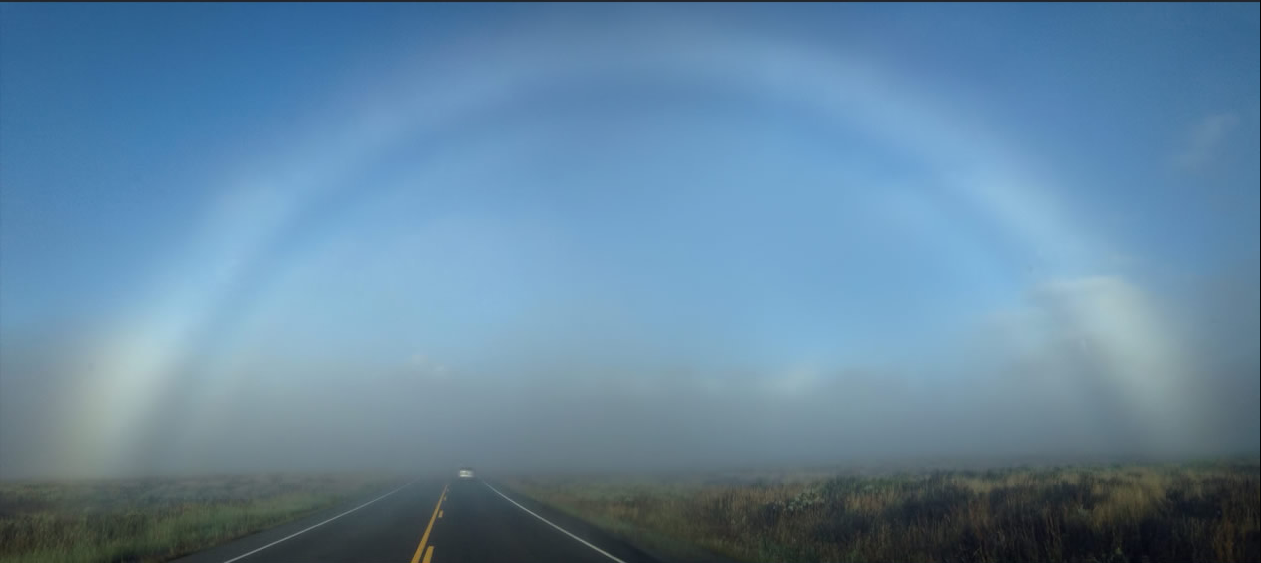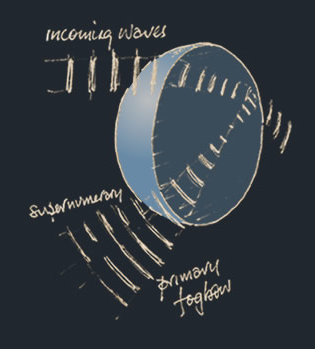Wyoming Fogbow - OPOD
Wyoming Fogbow: A Stunning Atmospheric Optics Phenomenon
Have you ever witnessed a breathtaking sight in the sky that left you in awe? One such spectacle is the Wyoming Fogbow, a dramatic atmospheric optics phenomenon that can captivate anyone lucky enough to witness it. In this article, we will delve into the fascinating world of fogbows, exploring their formation, unique characteristics, and the science behind their mesmerizing appearance.
The Enigmatic Wyoming Fogbow
The Wyoming Fogbow is an impressive sight, spanning an enormous diameter of approximately 80°. It was expertly captured by photographer John Speier as he approached the majestic Grand Tetons. Speier skillfully combined two images using a phone app, as the iPhone alone couldn't capture the entire bow at once. The resulting photograph showcases the ethereal beauty of this natural wonder.
Unveiling the Science Behind Fogbows
Similar to rainbows, fogbows owe their existence to sunlight interacting with water droplets suspended in the air. However, there are some fundamental differences in the ingredients that create these two awe-inspiring optical phenomena. While rainbows form from large raindrops with diameters ranging from 1 to 2mm, fogbows arise from much smaller fog droplets measuring only 0.01 to 0.2mm in diameter.
The Role of Droplet Size and Wave Effects
The smaller size of fog droplets is a crucial factor that contributes to the unique appearance of fogbows. These tiny droplets are merely 10 to 100 times larger than the wavelengths of visible light, resulting in significant wave effects. As sunlight enters a water sphere containing fog droplets, it undergoes scattering in multiple directions due to the small size of the droplets.
Diffracted Light Waves and the Birth of a Fogbow
As sunlight interacts with the surface of fog droplets, the scattered light waves overlap and interfere with each other. This phenomenon, known as diffraction, causes the light to disperse in a broad and diffuse manner, forming a circle of light rather than the distinct, vibrant colors seen in rainbows. The diffraction effects present in rainbows can also be observed in fogbows, as evidenced by the appearance of supernumerary fringes.
Capturing the Wyoming Fogbow
If you're fortunate enough to encounter a Wyoming Fogbow, capturing its full grandeur can be a challenge. Due to its immense size, a polarizing filter should not be used if you wish to photograph the entire fogbow. However, if you're aiming to capture the supernumeraries—additional faint bands of color that occasionally accompany fogbows—a polarizer can enhance their visibility in your photographs.
The Mesmerizing Beauty of Atmospheric Optics
The Wyoming Fogbow is just one example of the captivating phenomena that can occur in our atmosphere. Atmospheric optics provides us with a window into the intricate interplay between sunlight and the elements in our environment. From rainbows and fogbows to halos and iridescent clouds, these enchanting spectacles remind us of the immense beauty that surrounds us.
In conclusion, the Wyoming Fogbow is a remarkable atmospheric optics phenomenon that enchants and mesmerizes all who have the privilege of witnessing it. Its large diameter, unique formation process involving small fog droplets, and the diffraction effects that create its ethereal appearance make it a captivating subject for photographers and enthusiasts alike. So, keep your eyes on the sky, for you never know when you might be treated to the awe-inspiring sight of a Wyoming Fogbow.

Wyoming Fogbow ~ A dramatic sighting by John Speier as he approached the Grand Tetons. "I combined two images using an app on my phone as the iPhone cannot capture the whole bow at once." Image ©John Speier, shown with permission

The fogbow is indeed large, some 80° diameter. Remember if attempting to catch it whole not to use a polarizing filter. Use a polarizer to capture supernumeraries though.
Sunlight making a fogbow follows the same recipe as that for a rainbow (84 degrees across at its red outer rim). Light enters a water sphere, reflects once from the opposite side and leaves in several directions almost back towards the sun. The difference is that large (1-2mm diameter) raindrops give rainbows while small fog droplets (0.01 - 0.2mm diameter) produce fogbows.
The smaller droplets are only 10-100 times the size of wavelengths of visible light and wave effects are therefore significant. At each surface the light waves are scattered in many directions and these outgoing scattered waves overlap and interfere - in other parlance they are diffracted. The result is a broad and diffuse circle of light rather than the sharper rainbow. However, rainbows themselves are not innocent of diffraction effects - witness their supernumerary fringes.
Note: this article has been automatically converted from the old site and may not appear as intended. You can find the original article here.
Reference Atmospheric Optics
If you use any of the definitions, information, or data presented on Atmospheric Optics, please copy the link or reference below to properly credit us as the reference source. Thank you!
-
<a href="https://atoptics.co.uk/blog/wyoming-fogbow-opod/">Wyoming Fogbow - OPOD</a>
-
"Wyoming Fogbow - OPOD". Atmospheric Optics. Accessed on April 24, 2024. https://atoptics.co.uk/blog/wyoming-fogbow-opod/.
-
"Wyoming Fogbow - OPOD". Atmospheric Optics, https://atoptics.co.uk/blog/wyoming-fogbow-opod/. Accessed 24 April, 2024
-
Wyoming Fogbow - OPOD. Atmospheric Optics. Retrieved from https://atoptics.co.uk/blog/wyoming-fogbow-opod/.